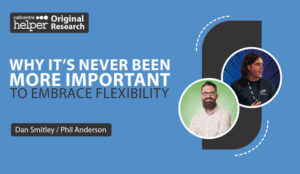When almost half of contacts set their schedules 3–4 weeks in advance, flexibility is a challenge – especially when it comes to keeping agents happy.
With strong opinions, an array of rotational patterns, and even zero-hours contracts in the mix, it can be a minefield too. That’s why we asked our expert panel to share their experiences of building true flexibility into the contact centre.
This is what they said…
How to Build Flexible Contact Centre Schedules
1. Focus on Continuous Improvement – Not a Quick Fix
Working patterns need to be considered as a continuous improvement cycle – not looked at every 2/3 years.
They can be a huge attraction and retention factor, so it’s incredibly important contact centres keep a close eye on them and build regular reviews into their processes.
2. Avoid the Fairness Trap
Flexible working options make it tough to make things fair. Yet fairness is a common word heard in these scenarios. Trying to make things fair can really compromise what you are trying to achieve.
Even with a single shift pattern, shifts-swaps, absence and annual leave mean most people work different shifts anyway.
Define what you mean by fair. People will compare themselves to others and perceive what they mean as fair regardless. You’ll never please everyone. The best you can do is to treat people as equally as possible, whilst also listening to individuals’ needs.
3. Operating Hours Should Not Be Set on Ease of Setting Them
Before looking at working patterns, you first need to look at your operating model, opening hours and skills required. Operating hours should not be set on ease of setting them!
7-7 or 8-8 may be easy from a marketing perspective, but the cost of being open and your ability to schedule to those hours must also be considered. Particularly as 12-hour days will need a minimum of 2 people to cover each day. Step back and think what’s best for your teams, customers, and the bottom line.
4. Give People a Sense of Certainty and Control
Late notice changes and uncertainty around annual leave can lead to anxiety. If someone feels in control, they will perform better. Do you need to reset the balance between flexibility and predictability?
5. Think Twice About Mandating Time in the Office
The pandemic has given people autonomy about when and where they work. Any plans for flexibility need to take this into consideration. Can you deliver it?
Think carefully about mandating time in the office without good reason. It can really drive problems with attrition.

6. Be Prepared to Challenge Bias
Changing schedules and shift patterns isn’t something you can achieve on your own. Agents and planners will need advice and guidance to make these changes happen successfully.
You’ll also need to be collectively prepared to challenge bias in the team. There will be strong views around this and planning teams will need to adapt quickly to succeed.
7. Stop Putting People Into Pre-Defined Groups
Learn about what your agents need and figure out what suits them – making assumptions can be a costly mistake!
8. You Have to Say ‘No’ Sometimes

Unfortunately, there will always be costs and practicalities involved in scheduling and not every offering is possible. You will need to say ‘no’ sometimes.
Although beware, if people are told ‘no’ all the time, they will start to think ‘what’s the point?’ and not see flexibility as a real offering in your contact centre. Sometimes it’s worth the occasional shift-swap that isn’t exactly ‘like for like’ to help keep teams happy. It’s all about balance.
9. Be Clear About Measures of Success
Be clear on the measures of success – looking at the commercials, as well as customer and colleague satisfaction. That way, you won’t lose focus.
Contributed by: Dave Vernon, The Forum.
10. Make Sure Agents Don’t Feel Shift Reviews Are Being ‘Done to Them’
When managers make changes seemingly ‘out of the blue’, agents can be left feeling as though shift reviews are being done to them. Try to collaborate more.
One positive way to collaborate is to split hours worked half and half – what’s best for the business, with some options for personal preferences too.
11. Remember It’s About People’s Lives – Not Just Graphs
What does flexibility actually mean? For me, flexibility is about efficiency, getting schedules to match the curve of volumes and ensuring we’re not wasting time with agents sitting doing nothing.
If planners had their way, there would be all sorts of funky shifts on offer – 1 hour here, 2 hours there, especially if a WFM system was left to its own devices!
But we must always remember there are also people involved. It’s not just about the numbers, planners have also got to get the balance right for agents.
12. People Are Expensive to Replace – Focus on Keeping Them Happy
Do whatever you can to encourage more flexibility in your contact centre. It’s really expensive to train people again and again – especially when the costs scale up in replacing up to 60% of your workforce each year (as some contact centres do).
If introducing that bit more flexibility into your contact centre can help people stay, why wouldn’t you?
13. Build Your Schedules Around People Who DON’T Want Flexibility First
Avoid ‘the flexibility trap’. It’s all too easy to put too much flexibility into your schedules to the point of creating numerous contracts and a logistical nightmare all round.
Take a step back and think about how much flexibility you actually need – how volatile is your business really? The majority of contact centres have quite static profiles throughout the week – so what are you trying to achieve?
I often find some people don’t want to be flexible, so it helps to build your schedules around those people first. Then, work on what flexibility you need with the people who want it.
14. Simple Solutions Can Often Be the Best All Round
There are a lot of flexibility options to choose from. Adding a lot of them into the mix – including job sharing, working from home, and compressed hours – can make flexibility really complex.
But it doesn’t have to be that way! Sometimes a simple change – such as introducing Sunday–Thursday and Tuesday–Saturday shift patterns can be a simple fix for weekend coverage instead.
15. Find People Who Want to Work the Unpopular Shifts

Managing the unpopular shifts is always a challenge – but there are people who will work them. It’s about finding those people using targeted recruitment. For example, promoting your late evening shifts to students.
Failing that, you could also try outsourcing your unpopular hours and taking the issue completely away from your core contact centre team.
16. Talk About Shift Patterns Up Front
Sadly, unpopular shift patterns are too often sprung on employees when they’ve already started the role, resulting in many going through training only to leave before they have to work the ‘horrible’ shift patterns on the floor.
Stop doing this! Instead, start conversations sooner in the process so people know what to expect and can make an informed decision.
Contributed by: Vosy Gordan, ModusRP
17. Let Agents Choose Their Preferences Up Front

Giving agents choice within constrained parameters can be the ultimate win–win in the contact centre. For example, they have to work one weekend a month – but can choose which weekend it is.
This works well if you give agents the option to state their availability before a rota is finalized – particularly if you use technology (including apps) to make it easy for the scheduling team to capture everyone’s preferences.
If you can combine needs in this way, agents will never be scheduled when they are not available. This makes it a lot easier to offer flexibility, whilst creating schedules that work and reduce the need for last-minute swaps.
Contributed by: Paul Chance, NICE
18. Record Meetings for Everyone
Record meetings if you can. That way, if not everyone is able to attend – due to flexible working options in play – you can allow them to watch the huddle or meeting at another time.
Contributed by: Fayth
19. Introduce Virtual Huddles
We use chat in Microsoft Teams throughout the day for virtual huddles.
Contributed by: Heather
20. Do Huddles First Thing in the Morning
I do huddles first thing in the morning before everyone jumps into their tasks for the day.
This allows for more flexibility and fewer interruptions across the day.
Contributed by: Jaizsha

21. Allow Swaps Wherever You Can
When you can, let agents of the same role swap shifts as they please.
Contributed by: Emma
22. Add Split-Shifts Into the Mix
A popular shift choice amongst our agents is a “split-shift”. They work 4 hours, have 4 hours off, and then come back to work another 4 hours. This helps cover those busy morning hours and late afternoon hours when our call volume is high.
Contributed by: Kimberly
23. Operate a Mix of Core Hours and Choice
Have core hours that need to be worked and choice around the rest. That way, you have cover when really needed, but also show you’re willing to be flexible to support staff and their work/life balance.
Contributed by: Emma
To find out more about contact centre shift patterns, read our research article: Contact Centre Shift Patterns: The Latest Findings
24. Teach Agents About Scheduling (How It’s Done and Its Challenges)
I give a presentation to each new group of agents about what is WFM, and the WFM software. I also explain all the scheduling options we have and ask them what they miss/would like to add. If possible, I also try to pilot some of their suggestions.
This really helps to get the working relationship off to a strong start of mutual understanding.
Contributed by: Nicolien
25. Introduce Regular Pow-Wows to Discuss What Agents Really Want
We have regular pow-wows focused on retention for employees to share ideas (including work/life balance and flexibility) and celebrate successes. It helps to keep employees motivated.
Contributed by: Jeremiah
26. Get Buy-In From More Influential Team Members Before Making Changes

When presenting a change to your scheduling, identify the leaders among your agents who seem to have the most influence.
Get their buy-in first and also their feedback, so when you present it to all the leaders, you have support for the change.
Contributed by: Fayth
27. Avoid High Volumes of Shift Categories – It Gets Confusing!
Shift patterns are difficult to set when we have a high number of agents and when we have more than 3 shift categories. Keep it simple.
Contributed by: Ahmad
28. Test New Ideas on Team Leaders First
I like to test out new schedule ideas on my team leaders first since it’s a smaller, more productive group.
Contributed by: Jaizsha
29. Give Part-Timers Freedom in Which Days They Have Off
We let our agents who work 60% or less choose the 1 or 2 days when they want to work, or want to be off. This makes it a more flexible arrangement for them – as opposed to just being told which days they have to work.
Contributed by: Inge
30. Make Sure Your Trainers Are on Board With WFM Tools
Make sure that people training or offering quality control feedback are on board with the WFM tool. Also, talk about what impact people being off the floor can have, and how to balance it to support the advisors.
Contributed by: Emma
31. Long-Range Forecasts Help You Plan How Many People You’ll Need
Developing long-range forecasts based on historic data can help you to identify demand up to 12 months out. When you know how many full-time employees (FTE) will be required, you are better able to go to stakeholders with projected workload and demand.
When you have the right number of people in post, it’s easier to offer flexibility that works for everyone. I also find it easier to recruit 6 weeks ahead of peak – for training and experience.
Contributed by: Karl
32. Let Agents Work the Unsociable Shifts From Home
We work all late shifts and weekends from home. This makes it a lot easier to get take-up and makes it easier for the agents too.
Contributed by: Nicolien
For more call and contact centre hints and tips, read these great articles next:
- 20 Tips for Forecasting and Scheduling on Digital Channels
- 20 Tips to Help Improve Your Capacity Planning
- 18 Tips for Boosting Contact Centre Performance With an FCR-First Strategy
Author: Robyn Coppell
Published On: 23rd Nov 2022 - Last modified: 2nd Dec 2025
Read more about - Hints and Tips, Dave Vernon, NiCE, Paul Chance, Scheduling, Shift Patterns, Staffing, Team Management, The Forum, Vatsana Gordon, Workforce Management (WFM), Workforce Planning






































